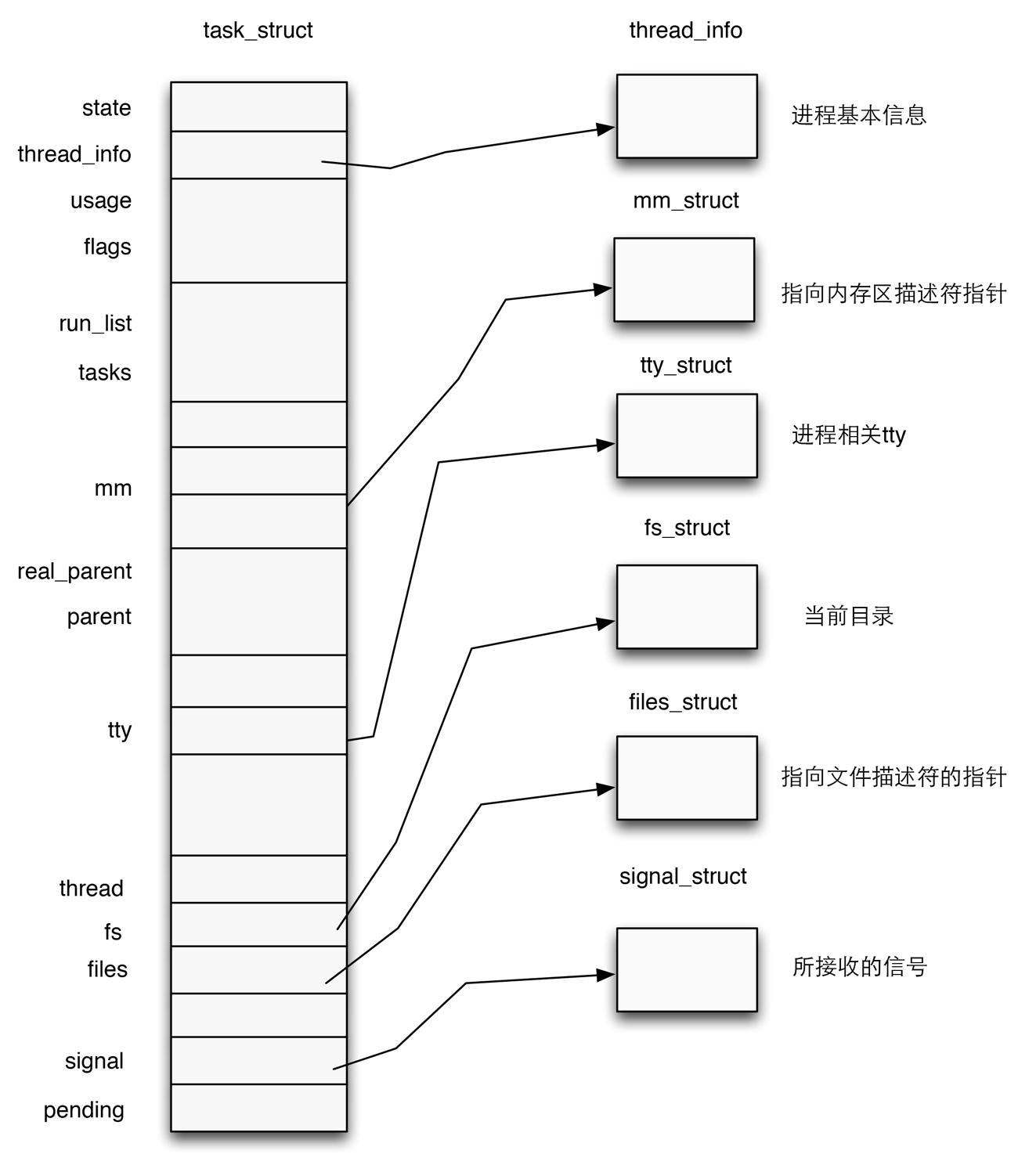| layout | title | category | description | tags |
|---|---|---|---|---|
post |
进程描述符 |
进程 |
进程描述符... |
进程描述符 进程状态 task_struct 资源限制 |
为了进程管理,内核必须对每个进程所做的事情进行清楚的描述。比如内核需要知道进程的优先级,进程当前的状态,在挂起和恢复进程的时候,需要对进程进行相应的操作。进程描述符还描述了进程使用的地址空间,访问的文件等等,这些都是进程描述符的作用。
进程描述符都是task_struct类型的结构,它的字段包含了与一个进程相关的所有信息。因为进程描述符中存放了那么多信息,所以它是非常复杂的,它不仅仅包括了很多进程属性的字段,还有一些字段包括了指向其他数据结构的指针,如下图:
进程有很多状态,从代码中我们可以看:
- volatile long state;
/* -1 unrunnable, 0 runnable, >0 stopped */
represents the state of the process.
Authorized states are
TASK_RUNNING, TASK_INTERRUPTIBLE, TASK_UNINTERRUPTIBLE,
TASK_STOPPED, TASK_TRACED
TASK_ZOMBIE and TASK_DEAD
可运行状态:
- TASK_RUNNING: 要么在CPU上执行,要么准备执行。
- TASK_INTERRUPTIBLE: 进程被挂起(睡眠),直到某个为真的条件触发,产生一个硬件中断,释放进程正等待的系统资源,或传递一个信号都可以唤醒进程。
- TASK_UNINTERRUPTIBLE: 不可中断的等待状态,与把信号传递给睡眠进程不能改变它的状态1。
- TASK_STOPPED: 进程的执行被暂停,当收到SIGSTOP、SIGTSTP、SIGTTIN或SIGTTOU信号后,进入暂停状态。
- TASK_TRACED: 跟踪状态,进程的执行由debugger程序暂停。
- TASK_ZOMBIE2: 进程执行被终止,但是父进程还没有发布wait4或waitpid系统调用返回有关死亡进程的信息。
- TASK_DEAD2: 僵死撤销状态。
task_struct可以看作是进程的一个实例,我并不想列出所有的代码,实际上理解进程也无需了解代码,毕竟笔记的目的只是为了了解,而不是做内核开发。但有时候特定的代码还是没办法完全忽略的。
{% highlight c++ %} /*
- 虽然有很多地方我们暂时还不是很了解,但是
- 以后会有很多机会重新回到这个数据结构,毕
- 竟这是内核中非常重要的数据结构。
- 进程管理和内存管理都是内核中非常重要的知
- 识,需要长期的理解和消化。 */ struct task_struct { // -1表示不可运行,0表示可运行,大于0表示停止 volatile long state; void *stack; atomic_t usage; // 每进程标志,上下文定义 unsigned int flags; unsigned int ptrace;
// 大内核锁的深度 int lock_depth;
#ifdef CONFIG_SMP #ifdef __ARCH_WANT_UNLOCKED_CTXSW int oncpu; #endif #endif // 优先级 int prio, static_prio, normal_prio; unsigned int rt_priority; const struct sched_class *sched_class; struct sched_entity se; struct sched_rt_entity rt;
#ifdef CONFIG_PREEMPT_NOTIFIERS /* 同步的通知者 */ struct hlist_head preempt_notifiers; #endif unsigned char fpu_counter; #ifdef CONFIG_BLK_DEV_IO_TRACE unsigned int btrace_seq; #endif
unsigned int policy; cpumask_t cpus_allowed;
#ifdef CONFIG_TREE_PREEMPT_RCU int rcu_read_lock_nesting; char rcu_read_unlock_special; struct rcu_node *rcu_blocked_node; struct list_head rcu_node_entry; #endif
#if defined(CONFIG_SCHEDSTATS)
|| defined(CONFIG_TASK_DELAY_ACCT)
struct sched_info sched_info;
#endif
struct list_head tasks; struct plist_node pushable_tasks;
struct mm_struct *mm, *active_mm;
/* 进程状态 */ int exit_state; int exit_code, exit_signal; // 在父进程终止时发送的信号 int pdeath_signal;
unsigned int personality; unsigned did_exec:1; unsigned in_execve:1; unsigned in_iowait:1;
unsigned sched_reset_on_fork:1;
// pid和组id pid_t pid; pid_t tgid;
#ifdef CONFIG_CC_STACKPROTECTOR unsigned long stack_canary; #endif
/*
- 分别指向原父进程
- 最年轻的子进程
- 年幼的兄弟进程
- 年长的兄弟进程的指针 */ struct task_struct *real_parent; struct task_struct *parent; struct list_head children; struct list_head sibling; // 线程组的组长 struct task_struct *group_leader;
struct list_head ptraced; struct list_head ptrace_entry;
struct bts_context *bts;
/* PID/PID散列表的关系 */ struct pid_link pids[PIDTYPE_MAX]; struct list_head thread_group;
// 用于vfork() struct completion *vfork_done; // CLONE_CHILD_SETTID int __user *set_child_tid; // CLONE_CHILD_CLEARTID int __user *clear_child_tid;
cputime_t utime, stime, utimescaled, stimescaled; cputime_t gtime; cputime_t prev_utime, prev_stime; // 上下文切换计数器 unsigned long nvcsw, nivcsw; // 单调时间 struct timespec start_time; // 启动以来的时间 struct timespec real_start_time; // 内存管理器失效和页交换信息 unsigned long min_flt, maj_flt;
struct task_cputime cputime_expires; struct list_head cpu_timers[3];
/* 进程身份 */ const struct cred *real_cred; const struct cred *cred; struct mutex cred_guard_mutex; struct cred *replacement_session_keyring;
char comm[TASK_COMM_LEN];
/* 文件系统信息 / int link_count, total_link_count; #ifdef CONFIG_SYSVIPC / ipc相关信息 / struct sysv_sem sysvsem; #endif #ifdef CONFIG_DETECT_HUNG_TASK unsigned long last_switch_count; #endif / 当前进程特定于CPU的状态信息 / struct thread_struct thread; / 文件系统信息 */ struct fs_struct fs; / 打开文件信息 */ struct files_struct files; / 命名空间 */ struct nsproxy nsproxy; / 信号处理程序 */ struct signal_struct *signal; struct sighand_struct *sighand;
sigset_t blocked, real_blocked; sigset_t saved_sigmask; struct sigpending pending;
unsigned long sas_ss_sp; size_t sas_ss_size; int (*notifier)(void *priv); void *notifier_data; sigset_t *notifier_mask; struct audit_context *audit_context; #ifdef CONFIG_AUDITSYSCALL uid_t loginuid; unsigned int sessionid; #endif seccomp_t seccomp;
/* 进程组的信息 */ u32 parent_exec_id; u32 self_exec_id; // 保护mm,files等信息的自旋锁 spinlock_t alloc_lock;
#ifdef CONFIG_GENERIC_HARDIRQS /* IRQ处理进程 */ struct irqaction *irqaction; #endif
spinlock_t pi_lock;
#ifdef CONFIG_RT_MUTEXES struct plist_head pi_waiters; struct rt_mutex_waiter *pi_blocked_on; #endif
#ifdef CONFIG_DEBUG_MUTEXES struct mutex_waiter *blocked_on; #endif #ifdef CONFIG_TRACE_IRQFLAGS unsigned int irq_events; int hardirqs_enabled; unsigned long hardirq_enable_ip; unsigned int hardirq_enable_event; unsigned long hardirq_disable_ip; unsigned int hardirq_disable_event; int softirqs_enabled; unsigned long softirq_disable_ip; unsigned int softirq_disable_event; unsigned long softirq_enable_ip; unsigned int softirq_enable_event; int hardirq_context; int softirq_context; #endif #ifdef CONFIG_LOCKDEP
u64 curr_chain_key; int lockdep_depth; unsigned int lockdep_recursion; struct held_lock held_locks[MAX_LOCK_DEPTH]; gfp_t lockdep_reclaim_gfp; #endif
/* 日志文件系统信息 */ void *journal_info;
/* 快设备信息 */ struct bio *bio_list, **bio_tail;
/* 虚拟内存状态 */ struct reclaim_state *reclaim_state;
struct backing_dev_info *backing_dev_info;
struct io_context *io_context;
unsigned long ptrace_message; siginfo_t last_siginfo; struct task_io_accounting ioac; #if defined(CONFIG_TASK_XACCT) u64 acct_rss_mem1; u64 acct_vm_mem1; cputime_t acct_timexpd; / stime + utime since last update */ #endif #ifdef CONFIG_CPUSETS nodemask_t mems_allowed; int cpuset_mem_spread_rotor; #endif #ifdef CONFIG_CGROUPS struct css_set *cgroups; struct list_head cg_list; #endif #ifdef CONFIG_FUTEX struct robust_list_head __user *robust_list; #ifdef CONFIG_COMPAT struct compat_robust_list_head __user *compat_robust_list; #endif struct list_head pi_state_list; struct futex_pi_state *pi_state_cache; #endif #ifdef CONFIG_PERF_EVENTS struct perf_event_context *perf_event_ctxp; struct mutex perf_event_mutex; struct list_head perf_event_list; #endif #ifdef CONFIG_NUMA struct mempolicy *mempolicy; short il_next; #endif atomic_t fs_excl; struct rcu_head rcu;
// ... {% endhighlight %}
每个进程都有一组相关的资源限制(resource limit),限制指定了进程能使用的系统资源数量。这些资源限制避免用户过分使用系统资源(CPU,磁盘空间等)。堆当前进程的资源限制存放在current->signal->rlim字段3,即进程描述符的一个字段。这个字段类型为rlimit结构的数组,每个资源限制对应一个元素:
{% highlight c++ %} struct rlimit { unsigned long rlim_cur; unsigned long rlim_max; }; {% endhighlight %}
资源限制包括:
| 字段名 | 说明 |
|---|---|
| RLIMIT_AS | 进程地址空间的最大数,以字节为单位,当进程使用malloc或相关函数的时候会检查这个值 |
| RLIMIT_CORE | 内存信息转储文件的大小,当一个进程异常终止时,内核在进程的当前目录下创建内存信息转储文件之前检查这个值 |
| RLIMIT_CPU | 进程使用CPU的最长时间,以秒为单位 |
| RLIMIT_DATA | 堆大小的最大值 |
| RLIMIT_FSIZE | 文件大小的最大值,如果进程把一个文件的大小扩充到这个值,内核就给这个进程发送SIGXFSZ信号 |
| RLIMIT_LOCKS | 文件锁数量的最大值 |
| RLIMIT_MEMLOCK | 非交换内存的最大值,当进程试图通过mlock或者mlockall锁住页框时,会检查这个值 |
| RLIMIT_MSGOUEUE | POSIX消息队列中的最大字节数 |
| RLIMIT_NOFILE | 打开文件描述符的最大数,打开一个文件或复制一个文件时会检查这个值 |
| RLIMIT_NPROC | 用户能拥有的进程最大数 |
| RLIMIT_RSS | 进程锁拥有的页框最大数 |
| RLIMIT_SIGPENDING | 进程挂起信号的最大数 |
| RLIMIT_STACK | 栈大小的最大值,内核在扩充进程的用户态堆栈之前检查这个值 |
